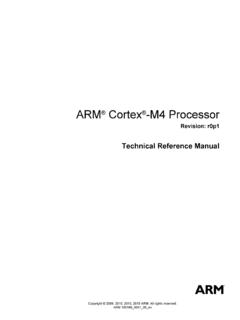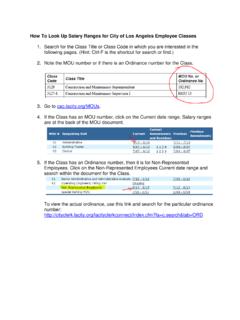Transcription of Atmel ATmega16U4, ATmega32U4 Datasheet Summary
1 Atmel -7766JS-USB-ATmega16U4/32U4-Datashe et_04/2016 Features High Performance, Low Power AVR 8-Bit Microcontroller Advanced RISC Architecture 135 Powerful Instructions Most Single Clock Cycle Execution 32 x 8 General Purpose Working Registers Fully Static Operation Up to 16 MIPS Throughput at 16 MHz On-Chip 2-cycle Multiplier Non-volatile Program and Data Memories 16/32KB of In-System Self-Programmable Flash Internal SRAM 512 Bytes/1KB Internal EEPROM Write/Erase Cycles: 10,000 Flash/100,000 EEPROM Data retention: 20 years at 85 C/ 100 years at 25 C(1) Optional Boot Code Section with Independent Lock BitsIn-System Programming by On-chip Boot ProgramTrue Read-While-Write OperationParts using external XTAL clock are pre-programed with a default USB bootloader Programming Lock for Software Security JTAG (IEEE std.)
2 Compliant) Interface Boundary-scan Capabilities According to the JTAG Standard Extensive On-chip Debug Support Programming of Flash, EEPROM, Fuses, and Lock Bits through the JTAG Interface USB Full-speed/Low Speed Device Module with Interrupt on Transfer Completion Complies fully with Universal Serial Bus Specification Rev Supports data transfer rates up to 12 Mbit/s and Endpoint 0 for Control Transfers: up to 64-bytes Six Programmable Endpoints with IN or Out Directions and with Bulk, Interrupt or Isochronous Transfers Configurable Endpoints size up to 256 bytes in double bank mode Fully independent 832 bytes USB DPRAM for endpoint memory allocation Suspend/Resume Interrupts CPU Reset possible on USB Bus Reset detection 48 MHz from PLL for Full-speed Bus Operation USB Bus Connection/Disconnection on Microcontroller Request Crystal-less operation for Low Speed mode Peripheral Features On-chip PLL for USB and High Speed Timer.
3 32 up to 96 MHz operation One 8-bit Timer/Counter with Separate Prescaler and Compare Mode ATmega16U4/ATmega32U48-bit Microcontroller with 16/32K bytes of ISP Flash andUSB ControllerDATASHEET SUMMARYAT mega16U4/32U4 [ Datasheet ] Atmel -7766JS-USB-ATmega16U4/3 2U4-Datasheet_04/20162 Two 16-bit Timer/Counter with Separate Prescaler, Compare- and Capture Mode One 10-bit High-Speed Timer/Counter with PLL (64 MHz) and Compare Mode Four 8-bit PWM Channels Four PWM Channels with Programmable Resolution from 2 to 16 Bits Six PWM Channels for High Speed Operation, with Programmable Resolution from 2 to 11 Bits Output Compare Modulator 12-channels, 10-bit ADC (features Differential Channels with Programmable Gain)
4 Programmable Serial USART with Hardware Flow Control Master/Slave SPI Serial Interface Byte Oriented 2-wire Serial Interface Programmable Watchdog Timer with Separate On-chip Oscillator On-chip Analog Comparator Interrupt and Wake-up on Pin Change On-chip Temperature Sensor Special Microcontroller Features Power-on Reset and Programmable Brown-out Detection Internal 8 MHz Calibrated Oscillator Internal clock prescaler and On-the-fly Clock Switching (Int RC / Ext Osc) External and Internal Interrupt Sources Six Sleep Modes: Idle, ADC Noise Reduction, Power-save, Power-down, Standby, and Extended Standby I/O and Packages All I/O combine CMOS outputs and LVTTL inputs 26 Programmable I/O Lines 44-lead TQFP Package, 10x10mm 44-lead QFN Package, 7x7mm Operating Voltages - Operating temperature Industrial (-40 C to +85 C) Maximum Frequency 8 MHz at - Industrial range 16 MHz at - Industrial rangeNote:1.
5 See Data Retention on page 8 for [ Datasheet ] Atmel -7766JS-USB-ATmega16U4/32U4-Datash eet_04 ConfigurationsFigure ATmega16U4/ ATmega32U4 is a low-power CMOS 8-bit microcontroller based on the AVR enhanced RISC architecture. By executing powerful instructions in a single clock cycle, the device achieves throughputs approaching 1 MIPS per MHz allowing the system designer to optimize power consumption versus processing QFN/TQFPUVccD-D+UGndUCapVBus(SS/PCINT0) PB0( ) PE6(PCINT1/SCLK) PB1(PDI/PCINT2/MOSI) PB2(PDO/PCINT3/MISO) PB3(PCINT7/OC0A/OC1C/RTS) PB7 RESETVCCGNDXTAL2 XTAL1(OC0B/ SCL/ INT0) PD0(SDA/ INT1) PD1(RXD1/ INT2) PD2(TXD1/INT3) PD3(XCK1/ CTS) PD5PE2 (HWB)PC7 (ICP3/CLK0/OC4A)PC6 (OC3A/OC4A)PB6 (PCINT6/OC1B/OC4B/ADCPB4 (PCINT4/ADC11)PD7 (T0/OC4D/ADC10))
6 PD6 (T1/OC4D/ADC9)PD4 (ICP1/ADC8)AVCCGNDAREFPF0 (ADC0)PF1 (ADC1)PF4 (ADC4/ TCK)PF5 (ADC5/ TMS)PF6 (ADC6/ TDO)PF7 (ADC7/ TDI)GNDVCCINDEX CORNER1234567891011333231302928272625242 3121314151617181920212244434241403938373 63534PB5 (PCINT5/OC1A/OC4B/ADCAVCCGNDAT mega16U4/32U4 [ Datasheet ] Atmel -7766JS-USB-ATmega16U4/3 2U4-Datasheet_04 DiagramFigure DiagramThe AVR core combines a rich instruction set with 32 general purpose working registers. All the 32 registers are directly connected to the Arithmetic Logic Unit (ALU), allowing two independent registers to be accessed in one single instruction executed in one clock cycle.)
7 The resulting architecture is more code efficient while achieving throughputs up to ten times faster than conventional CISC device provides the following features: 16/32K bytes of In-System Programmable Flash with Read-While-Write capabilities, 512 Bytes/1K bytes EEPROM, bytes SRAM, 26 general purpose I/O lines (CMOS outputs and LVTTL inputs), 32 general purpose working registers, four flexible Timer/Counters with compare modes and PWM, one more high-speed Timer/Counter with compare modes and PLL adjustable source, one USART (including CTS/RTS flow control signals)
8 , a byte oriented 2-wire Serial Interface, a 12-channels 10-bit ADC with optional differential input stage with programmable gain, an on-chip calibrated temperature sensor, a programmable Watchdog Timer with Internal Oscillator, an SPI serial port, IEEE std. compliant JTAG test interface, also used for accessing the On-chip Debug system and programming and six software selectable PROGRAMCOUNTERSTACKPOINTERPROGRAMFLASHMC U CONTROLREGISTERGENERALPURPOSEREGISTERSIN STRUCTIONREGISTERTIMERS/COUNTERSINSTRUCT IONDECODERDATA PORTBDATA PORTEDATA PORTDDATA REGISTERPORTBDATA REGISTERPORTEDATA REGISTERPORTDINTERRUPTUNITEEPROMSPISTATU SREGISTERSRAMUSART1 ZYXALUPORTB DRIVERSPORTE DRIVERSPORTF DRIVERSPORTD DRIVERSPORTC DRIVERSPB7 - PB0PE6PF7 - PF4 RESETVCCGNDXTAL1 XTAL2 CONTROLLINESPC7 INTERNALOSCILLATORWATCHDOGTIMER8-BIT DA TA BUSUSB
9 ANDCONTROLOSCILLATORCALIB. OSCDATA PORTCDATA REGISTERPORTCON-CHIP DEBUGJTAG TAPPROGRAMMINGLOGICBOUNDARY- SCANDATA PORTFDATA REGISTERPORTFPOR - BODRESETPD7 - PD0 TWO-WIRE SERIALINTERFACEPLLHIGH SPEEDTIMER/PWMPE2PC6PF1PF0ON-CHIPUSB PAD 3 VREGULATORUVccUCap1uFANALOGCOMPARATORVBU SDPDMADCAGNDAREFAVCCTEMPERATURESENSOR5 ATmega16U4/32U4 [ Datasheet ] Atmel -7766JS-USB-ATmega16U4/32U4-Datash eet_04/2016power saving modes. The Idle mode stops the CPU while allowing the SRAM, Timer/Counters, SPI port, and interrupt system to continue functioning. The Power-down mode saves the register contents but freezes the Oscillator, disabling all other chip functions until the next interrupt or Hardware Reset.
10 The ADC Noise Reduction mode stops the CPU and all I/O modules except ADC, to minimize switching noise during ADC conversions. In Standby mode, the Crystal/Resonator Oscillator is running while the rest of the device is sleeping. This allows very fast start-up combined with low power device is manufactured using the Atmel high-density nonvolatile memory technology. The On-chip ISP Flash allows the program memory to be reprogrammed in-system through an SPI serial interface, by a conventional nonvolatile memory programmer, or by an On-chip Boot program running on the AVR core.











